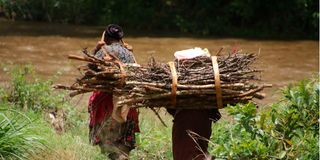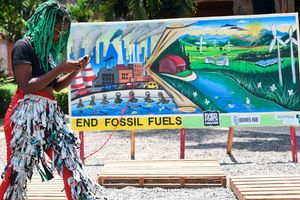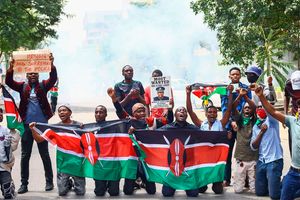
Women carry firewood on their backs in Thageini, Nyeri County on April 12, 2024.
Rural communities are the quiet wheels that power our world: hubs of food production, guardians of the most critical ecosystems, and anchors of cultural heritage. Yet they remain some of the most underinvested and overlooked. As the world confronts the polycrises of climate change, poverty, and food insecurity, there is a growing recognition that rural transformation is not optional. It is an essential part of building lasting resilience for any nation and it must begin with meaningful investment, not just acknowledgment.
Sunday, July 6, we mark a historic milestone: the first-ever World Rural Development Day. For the first time, the United Nations has formally recognised what rural communities have always known: that the future of our planet depends on the vitality, resilience, and ingenuity of rural people.
This is a long-overdue acknowledgment: that we cannot build a just, sustainable, and prosperous world while half of humanity (those who grow our food, safeguard our forests, and sustain our cultures) are left behind. Yet this moment is as ironic as it is inspiring. Because while rural development is finally being celebrated in principle, in practice it remains chronically underfunded. Rural communities are hailed as essential, but rarely resourced as such. There is a persistent disconnect between global rhetoric and real investment.
As global leaders gather in Seville for the Fourth International Conference on Financing for Development (FFD4), we must remind ourselves that there is no development without finance. And there can be no meaningful financing strategy that ignores rural areas. The intersection of FFD4 and World Rural Development Day is therefore a wake-up call that underscores a glaring gap in our global financing architecture: the failure to channel resources to the people and places most critical to our collective future.
Foundation of sustainable development
Let’s consider the facts. The World Bank reports that 80 per cent of the world’s extreme poor live in rural areas. In Africa, the figure climbs to just over 80 per cent: nearly half a billion people. In these regions, poverty is not just about a lack of income; it’s a reflection of generations of structural neglect.
For too long, public investment, infrastructure, and policymaking have favored urban centres. This enduring “urban bias,” a term coined by development economist Michael Lipton, has turned rural areas into zones of outmigration where the only escape is often a one-way trip to the city.
But what if we flipped the script? What if we stopped seeing rural areas as pockets of poverty and instead viewed them as hubs of possibility, as centers of knowledge, climate resilience, and inclusive growth? What if rural prosperity was not an afterthought, but the foundation of sustainable development?
To do that, we must reimagine the financial architecture that governs rural development.
As UNEP’s Director of Policy and Programmes, Jyotsna Puri rightly points out that the global credit-rating system is broken and that makes it both difficult and costly to continue to borrow much needed capital for investment. Today, developing countries, many of them predominantly rural, face borrowing costs at least five percentage points higher than those of developed nations. This unjust premium is not about economic fundamentals; it is about a flawed system that equates the rural with the risky. Institutions like Fitch, Moody’s, and S&P wield outsize influence, but their frameworks fail to account for the realities and the potential of rural economies.
World Rural Development Day
The Compromiso de Sevilla responds to this injustice. It calls for reforming global financial architecture to lower the cost of capital for developing countries, scale investment in rural infrastructure, and empower national and regional development banks. Critically, it endorses new credit mechanisms like the Africa Credit Rating Agency (AfCRA) — an African-led initiative launching this year to provide fairer assessments of sovereign risk. These are promising steps toward leveling the financial playing field. But beyond systems and structures, rural development must be rooted in the leadership of the people who live there.
If we are truly serious about achieving the SDGs, and honoring the spirit of the Sevilla Commitment, then we must stop treating rural areas as the margins of development. They are investment frontiers. They are centers of ingenuity, resilience, and opportunity.
The solutions already exist, in the hands of farmers, forest guardians, women, and youth who are innovating every day. What they need is not more promises, but real partnership. Not more pilots, but scaled-up investment. So on this first World Rural Development Day, let’s do more than recognise. Let’s reimagine. Let’s commit to financing hope and real opportunity.
Ms Mathai is the MD for Africa & Global Partnerships at the World Resources Institute and Chair of the Wangari Maathai Foundation







